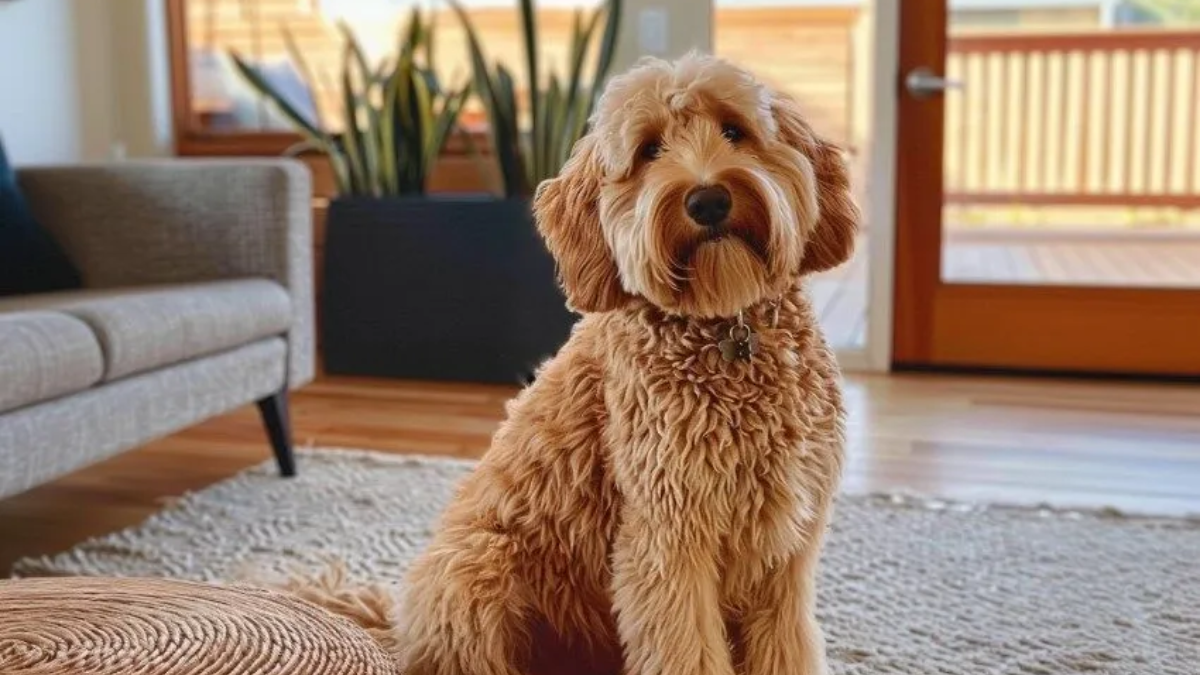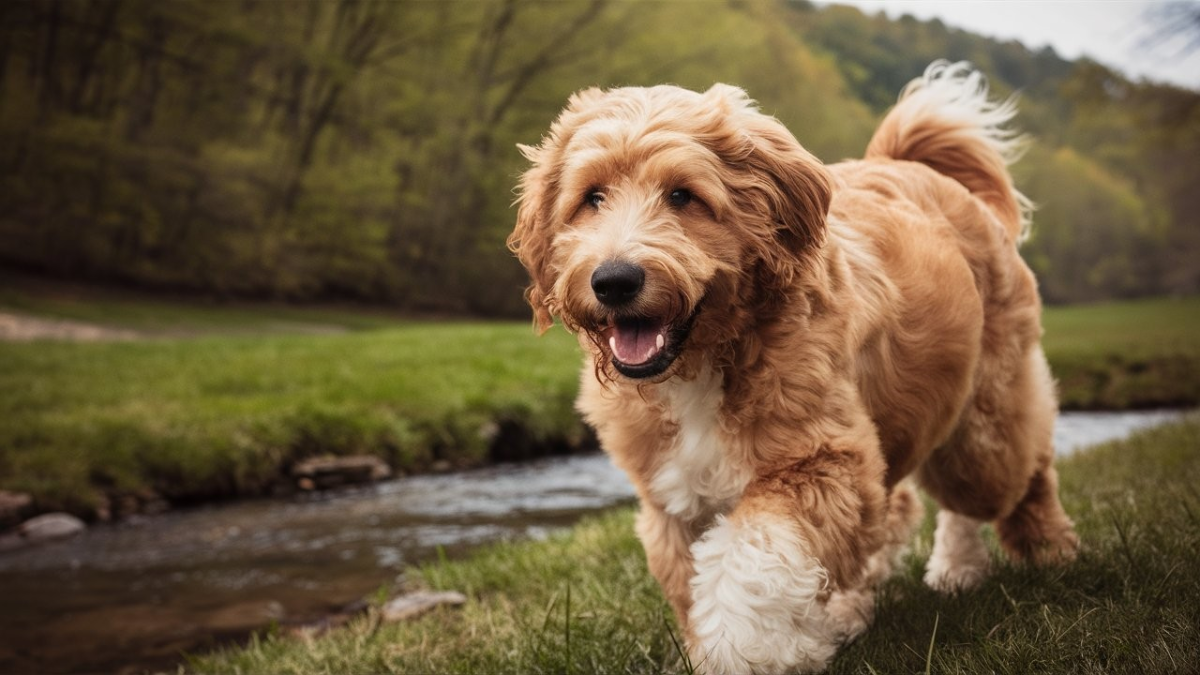The Double Doodle is a hybrid dog breed that combines the genetic traits of the Goldendoodle (Golden Retriever and Poodle mix) and the Labradoodle (Labrador Retriever and Poodle mix). This designer breed capitalizes on the often sought-after qualities of three pedigree breeds, purportedly aiming to produce a canine with a friendly and affectionate nature, intelligence, and a low-shedding coat.
As with many hybrid dogs, the intention behind the creation of the Double Doodle is to blend desirable features from its parent breeds into a single dog that could potentially make a suitable pet for a variety of owners.

Having emerged in recent years, the Double Doodle is yet to be recognized by major kennel clubs. However, this lack of official recognition does not detract from the popularity of the breed among those looking for a pet that exhibits both the gentle disposition of the Golden Retriever and Labrador Retriever and the hypoallergenic qualities of the Poodle. As a designer breed, prospective owners need to understand that the Double Doodle's characteristics can vary widely even within the same litter due to the complex nature of its genetic inheritance.
The origin of the Double Doodle can be traced back to a trend that gained momentum in the late 20th century when breeders began crossing purebred dogs to achieve specific traits. Over time, these crossbreeds have gained a substantial following, with Double Doodles becoming part of a larger movement that champions the deliberate mixing of established breeds. Their increased prevalence is also tied to ongoing debates about the health and temperament advantages of hybrid vigor, which is the idea that crossbreeds dogs may benefit from a wider genetic pool that can potentially reduce the likelihood of hereditary health issues.
Breed Characteristics
The Double Doodle combines the genetic traits of the Poodle, Labrador Retriever, and Golden Retriever, resulting in a hybrid breed with distinct appearance, temperament, and health profiles.

Appearance
Double Doodles possess a unique look that blends characteristics from its parent breeds. Commonly, they exhibit a coat that can be wavy, straight, or curly, depending on the generation of breeding. Their coats come in a variety of colors including cream, black, and the less common multi-colored merle. Typically, they have the iconic floppy ears of a Lab or Golden Retriever and dark button eyes that express their friendly disposition.
| Trait | Description |
|---|---|
| Size | Varies from medium to large based on the specific mix |
| Coat Type | Wavy, straight, or curly |
| Colors | Ranges from cream to black, including multi-colored merle |
| Ear Type | Floppy |
| Eye Appearance | Dark and button-shaped |
Temperament
Double Doodles are known for their friendly, intelligent, and loving nature. They are sociable which makes them excellent family pets. Their energetic and playful behavior is often accompanied by the intelligent and trainable disposition of the Poodle, which when combined with the loving and sociable attributes of the Labrador and Golden Retriever, creates an adaptable and well-natured companion.

Behavioral Traits:
- Friendly: They thrive on human interaction.
- Intelligent: Highly trainable due to their Poodle heritage.
- Loving: Display strong bonds with their family members.
- Sociable: Get along well with other pets and children.
- Energetic: Need regular exercise to manage their vigor.
Health and Lifespan
Health considerations for Double Doodles include traditional concerns prevalent in their parent breeds. Hip dysplasia, elbow dysplasia, cataracts, hypothyroidism, and ear infections are conditions to be mindful of. Regular veterinary checks are advised to monitor and manage these health issues. With proper care, the typical lifespan of a Double Doodle ranges from 12 to 15 years.
Common Health Issues:
- Hip Dysplasia: Joint condition impacting mobility.
- Elbow Dysplasia: This could lead to arthritis or lameness.
- Cataracts: Can cause vision impairment.
- Hypothyroidism: Affects metabolism and overall health.
- Ear Infections: Due to their floppy ears, regular cleaning is crucial.
Maintaining a healthy lifestyle with appropriate diet, exercise, and veterinary care maximizes their potential lifespan while minimizing the risk of genetic health problems.
Maintenance and Care
Proper maintenance and care are crucial for a Double Doodle's health and happiness. Addressing grooming needs, ensuring regular exercise, and maintaining a balanced diet are central to their well-being.
Grooming
The Double Doodle, a cross between two hypoallergenic breeds, may have a coat that ranges from wavy to curly. Regular grooming is essential to prevent matting and to manage shedding. They should be brushed several times a week, utilizing tools appropriate for their coat type. Bathing should be done with a mild dog shampoo roughly every 3-4 weeks or as needed.

Exercise and Training
Due to their intelligent and energetic nature, Double Doodles require consistent exercise and training. They thrive on at least 30 to 60 minutes of daily physical activity, which could include walks, playtime, or agility training. Regular obedience training from an early age fosters mental stimulation and good behavior. Their high energy level and need for exercise should not be underestimated to maintain optimal weight and health.
Diet and Health Issues
Feeding a Double Doodle involves offering measured portions of high-quality dog food twice a day, with consideration for their size and activity level to prevent obesity. Foods rich in glucosamine can benefit their joints. Double Doodles may be predisposed to certain health issues such as diabetes, bloat, gum disease, and joint problems. Regular veterinary check-ups can help identify and manage any health concerns early on.
Breed Specifics
The Double Doodle combines characteristics of several friendly and intelligent breeds, resulting in variations in size, coat, and genetic diversity.
Origin and History
The Double Doodle is a hybrid breed, conceptualized with the goal of combining the desirable traits of the Golden Labradoodle (a mix of the Golden Retriever and Standard Poodle) and the North American Retriever/Aussiedoodle (a combination of the Australian Shepherd and a Standard Poodle). This designer dog carries a heritage rich with the friendliness and intelligence of its predecessors, with a lineage that sees it related to the Bernedoodle and Golden Mountain Doodle.
- Australian Labradoodle: Derived from Labrador Retriever and Poodle lineage
- Aussie Goldendoodle: Blend of Australian Shepherd and Golden Retriever genetics, often with a Poodle

Breed Variations
Sizes:
- Mini Double Doodle: Smaller size due to the involvement of a Miniature Poodle
- Standard Labradoodle: Larger size, involving a Standard Poodle
| Size Classification | Descriptive Traits |
|---|---|
| Mini | Under 30 pounds, compact |
| Medium | 30-45 pounds, mid-sized stature |
| Standard | Over 45 pounds, more space and exercise required |
Coat and Colors:
The attractiveness of the Double Doodle is partly due to its hypoallergenic coat, which can exhibit a variety of colors including solids, partis, and the sought-after tri-color coat. The coat types can vary from curly to wavy, bringing out the non-shedding qualities of its Poodle lineage.
- Coat Colors: Cream, Gold, Black, Chocolate, and even rare Phantom
- Hybrid Vigor: Genetic diversity aims for a healthier population
| Feature | Description |
|---|---|
| Hypoallergenic | Reduced shedding, suitable for allergies |
| Coat Variability | Curly to wavy, often non-shedding |
| Life Expectancy | Ranges from 12 to 15 years |

Given the varying characteristics of the parent breeds, potential owners can expect a range of personalities and physical features in a Double Doodle. With proper care, these dogs enjoy a robust life expectancy, embodying the optimum qualities of designer dog breeds.
Conclusion:
In conclusion, Double Doodle is truly the heart and soul of any home. With their boundless energy and affectionate nature, they seamlessly blend into family life, bringing warmth and happiness to every moment. Whether it's playtime in the yard or cozying up on the couch, Double Doodles make every day an adventure filled with love. Consider welcoming one of these delightful mixed-breed companions into your life and discover the joy they bring firsthand.




